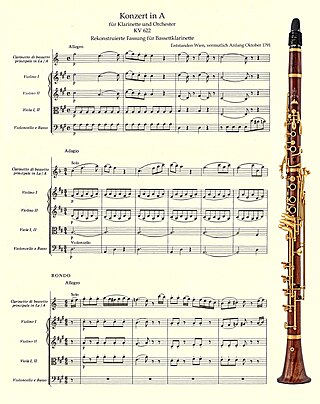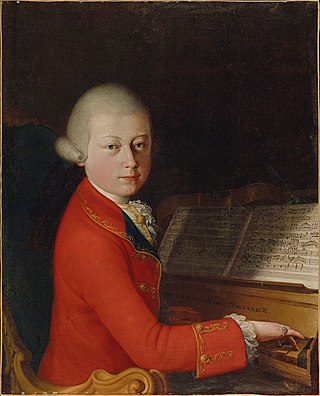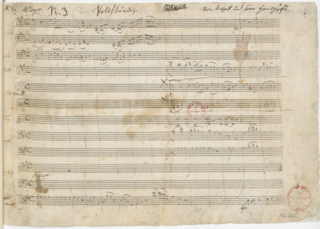
In music, a cadenza, is, generically, an improvised or written-out ornamental passage played or sung by a soloist(s), usually in a "free" rhythmic style, and often allowing virtuosic display. During this time the accompaniment will rest, or sustain a note or chord. Thus an improvised cadenza is indicated in written notation by a fermata in all parts. A cadenza will usually occur over either the final or penultimate note in a piece, the lead-in, or the final or penultimate note in an important subsection of a piece. A cadenza can also be found before a final coda or ritornello.
A concerto is, from the late Baroque era, mostly understood as an instrumental composition, written for one or more soloists accompanied by an orchestra or other ensemble. The typical three-movement structure, a slow movement preceded and followed by fast movements, became a standard from the early 18th century.

Wolfgang Amadeus Mozart's Clarinet Concerto in A major, K. 622, was completed in October 1791 for the clarinettist Anton Stadler. It consists of three movements, in a fast–slow–fast succession.

The Bassoon Concerto in B-flat major, K. 191/186e, is a bassoon concerto written in 1774 by Wolfgang Amadeus Mozart. It is the most often performed and studied piece in the entire bassoon repertory. Nearly all professional bassoonists will perform the piece at some stage in their career, and it is probably the most commonly requested piece in orchestral auditions – it is usually requested that the player perform excerpts from the concerto's first two movements in every audition.
E major is a major scale based on E, consisting of the pitches E, F♯, G♯, A, B, C♯, and D♯. Its key signature has four sharps. Its relative minor is C-sharp minor and its parallel minor is E minor. Its enharmonic equivalent, F-flat major, has six flats and the double-flat B, which makes it impractical to use.

The Symphony No. 38 in D major, K. 504, was composed by Wolfgang Amadeus Mozart in late 1786. It premiered in Prague on January 19, 1787, during Mozart's first visit to the city. Because it was first performed in Prague, it is popularly known as the Prague Symphony. Mozart's autograph thematic catalogue records December 6, 1786, as the date of completion for this composition.

Wolfgang Amadeus Mozart's Violin Concerto No. 1 in B♭ major, K. 207, once was supposed to have been composed in 1775, along with the other four wholly authentic violin concertos. However, analysis of handwriting and the manuscript paper on which the concerto was written suggest that the date of composition might have been 1773. It has the usual fast–slow–fast structure.

The Violin Concerto No. 3 in G major, K. 216, was composed by Wolfgang Amadeus Mozart in Salzburg in 1775 when he was 19 years old. In a letter to his father, Mozart called it the "Straßburg-Concert". Researchers believe this epithet comes from the motive in the third movement's Allegretto in the central section, a local dance that already had appeared as a musette-imitating tune in a symphony by Carl Ditters von Dittersdorf.

The Piano Concerto No. 23 in A major K. 488 is a concerto for piano and orchestra written by Wolfgang Amadeus Mozart. It was finished, according to Mozart's own catalogue, on March 2, 1786, two months prior to the premiere of his opera, Le nozze di Figaro, and some three weeks prior to the completion of his next piano concerto. It was one of three subscription concerts given that spring and was probably played by Mozart himself at one of these.

The Violin Concerto No. 5 in A major, K. 219, often referred to by the nickname "Turkish", was written by Wolfgang Amadeus Mozart in 1775, premiering during the Christmas season that year in Salzburg. It follows the typical fast–slow–fast musical structure.

Wolfgang Amadeus Mozart's Oboe Concerto in C major, K. 314 (271k), was composed in the spring or summer of 1777, for the oboist Giuseppe Ferlendis (1755–1802) from Bergamo. In 1778, Mozart re-worked it as a concerto for flute in D major. The concerto is a widely studied piece for both instruments and is one of the most important concertos in the oboe repertoire.

Wolfgang Amadeus Mozart's Piano Concerto No. 12 in A major, K. 414 (385p), was written in the autumn of 1782 in Vienna. It is scored for solo piano, two oboes, two bassoons (optional), two horns, and strings. Like all three of the early Vienna concertos that Mozart wrote, it is a modest work that can be performed with only string quartet and keyboard. As per 18th century performance practice a string orchestra could also have served as a suitable option for the "quattro" accompaniment.

The Piano Concerto No. 22 in E♭ major, K. 482, is a work for piano, or fortepiano, and orchestra by Wolfgang Amadeus Mozart, composed in December 1785.
Violin Concerto No. 4 in D major, K. 218, was composed by Wolfgang Amadeus Mozart in 1775 in Salzburg. The autograph of the score is preserved in the Biblioteka Jagiellońska, Kraków. He seemed to have originally composed it for himself to play, but after leaving the Salzburg Court Orchestra, he changed and updated the concerto for the successor of his position in his orchestra, Antonio Brunetti, to play. It is debatable whether the concerto was above Mozart's level of mastery or if he purposely made the concerto difficult for Brunetti on account of his greater ability. The first movement is nicknamed the “military” Mozart Concerto while the second movement consists of melodic lines. The third movement is joyful and full of fun.

Wolfgang Amadeus Mozart's concertos for piano and orchestra are numbered from 1 to 27. The first four numbered concertos and three unnumbered concertos are early works that are arrangements of keyboard sonatas by various contemporary composers. Concertos 7 and 10 are compositions for three and two pianos respectively. The remaining twenty-one are original compositions for solo piano and orchestra. These works, many of which Mozart composed for himself to play in the Vienna concert series of 1784–86, held special importance for him.

The Flute Concerto No. 1 in G major, K. 313, was written in 1778 by Wolfgang Amadeus Mozart.
An organ concerto is an orchestral piece of music in which a pipe organ soloist is accompanied by an an orchestra, although some works exist with the name "concerto" which are for organ alone.
Carl Maria von Weber wrote his Clarinet Concerto No. 1 in F minor, Op. 73 for the clarinettist Heinrich Bärmann in 1811. The piece is highly regarded in the instrument's repertoire. It is written for clarinet in B♭. The work consists of three movements in the form of fast, slow, fast. It was premiered in Munich on 13 June 1811, with Maximilian I Joseph of Bavaria in attendance.

The Sinfonia Concertante for Four Winds in E-flat major, K. 297b, is a work thought to be by Wolfgang Amadeus Mozart for oboe, clarinet, horn, bassoon, and orchestra. He originally wrote a work for flute, oboe, horn, bassoon, and orchestra, K. Anh. 9 (297B), in Paris in April 1778. This original work is lost.










